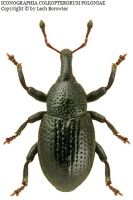
Русские, остановите эту войну! Спасите Свободную Украину!
Russians, stop this war! Save Free Ukraine!
Biodiversity Map
Taxa

Leiosoma — subordinate taxa:
Taxon count: 5
-
Leiosoma bosnicumSet as tree root ↑
Show taxon data → ⚑ [21] → Show taxon data
[21] → Show taxon data -
Leiosoma cribrumSet as tree root ↑
Show taxon data → ⚑ [193] → Show taxon data
[193] → Show taxon data -
Leiosoma deflexumSet as tree root ↑
Show taxon data → ⚑ [104] → Show taxon data
[104] → Show taxon data -
Leiosoma oblongulumSet as tree root ↑
Show taxon data → ⚑ [19] → Show taxon data
[19] → Show taxon data -
Leiosoma oblongumSet as tree root ↑
Show taxon data → → Show taxon data
-
Arthropodaphylum
Click to switch
to select orders
and filters > -
Hexapodasubphylum
Click to switch
to select orders
and filters > -
Insectaclass
Click to switch
to select orders
and filters > -
Coleopteraorder
Click to set
as the main taxon
and as a base
← of the left panel > -
Polyphagasuborder
Click to set
as the main taxon
and as a base
← of the left panel > -
Cucujiformiaseries
Click to set
as the main taxon
and as a base
← of the left panel > -
Curculionoideasuperfamily
Click to set
as the main taxon
and as a base
← of the left panel > -
Curculionidaefamily
Click to set
as the main taxon
and as a base
← of the left panel > -
Molytinaesubfamily
Click to set
as the main taxon
and as a base
← of the left panel > -
Molytinitribe
Click to set
as the main taxon
and as a base
← of the left panel > -
Leiosomagenus
Click to set
as the main taxon
and as a base
← of the left panel >
PL
YES
name status: valid name
BioMap ID: 1046958
taxon code: 5391
taxonomy checked: YES
Polish Red List: LC
Data on distribution in Poland

Statistics
- Records: 19
- Publications: 13
- Collections: no data
- Publication authors: 10
- Illustrations (iconography): 1
- Photos (specimen/observation): lacking
Taxon description
Gatunek obejmujący zasięgiem obszary górzyste w środkowej części Europy; notowany ponadto z Francji i Anglii. W Polsce należy do wielkich rzadkości; jest wykazany tylko z dwu krain południowych. Bionomia tego ryjkowca słabo poznana. Zasiedla wilgotne lasy liściaste, zarośla oraz mokre łąki. Postacie dojrzałe poławiano od marca na jaskrze rozłogowym — Ranunculus repens L., zawilcu gajowym — Anemone nemorosa L. i orliku pospolitym — Aquilegia vulgaris L.; ponadto spotykano go sporadycznie w ściółce i wśród mchów.
Illustrations
... browse
 Leiosoma
Leiosomaoblongulum
External data sources
- Ostatnie rekordy
-
800233
 ×
× Curculionidae: Leiosoma oblongulum, PL (Petryszak 1993b)
Curculionidae: Leiosoma oblongulum, PL (Petryszak 1993b) -
800232
 ×
× Curculionidae: Leiosoma oblongulum, PL (Knutelski 2000)
Curculionidae: Leiosoma oblongulum, PL (Knutelski 2000) -
800231
 ×
× Curculionidae: Leiosoma oblongulum, PL (Knutelski et Witkowski 1995)
Curculionidae: Leiosoma oblongulum, PL (Knutelski et Witkowski 1995) -
800230
 ×
× Curculionidae: Leiosoma oblongulum, PL (Knutelski et Skalski 1993)
Curculionidae: Leiosoma oblongulum, PL (Knutelski et Skalski 1993) -
800229
 ×
× Curculionidae: Leiosoma oblongulum, PL (Knutelski 1991a)
Curculionidae: Leiosoma oblongulum, PL (Knutelski 1991a) -
736863
 ×
× Curculionidae: Leiosoma oblongulum, PL (Knutelski 1991a)
Curculionidae: Leiosoma oblongulum, PL (Knutelski 1991a) -
190648
 ×
× Curculionidae: Leiosoma oblongulum, PL, «Karpaty» (Łomnicki 1913, Burakowski et al. 1995)
Curculionidae: Leiosoma oblongulum, PL, «Karpaty» (Łomnicki 1913, Burakowski et al. 1995) -
153916
 ×
× Curculionidae: Leiosoma oblongulum, PL, «Polska» (Mroczkowski et Stefańska 1991, Burakowski et al. 1995)
Curculionidae: Leiosoma oblongulum, PL, «Polska» (Mroczkowski et Stefańska 1991, Burakowski et al. 1995) -
153915
 ×
× Curculionidae: Leiosoma oblongulum, PL, «Polska» (Lucht 1987, Burakowski et al. 1995)
Curculionidae: Leiosoma oblongulum, PL, «Polska» (Lucht 1987, Burakowski et al. 1995) -
153914
 ○
○ Curculionidae: Leiosoma oblongulum, PL, Pieniny, UTM DV57 (Knutelski et Skalski 1993, Burakowski et al. 1995)
Curculionidae: Leiosoma oblongulum, PL, Pieniny, UTM DV57 (Knutelski et Skalski 1993, Burakowski et al. 1995) - ... more
- Powiązane publikacje
-
Knutelski S. 2000. Uwagi o ryjkowcach (Coleoptera, Curculionoidea) Kotliny Nowotarskiej. Chr. Przyr. Ojcz., 56(2):51-67.
 Show records
Show records -
Knutelski S., Witkowski Z.J. 1995. Ryjkowce (Coleoptera: Curculionoidea) obszaru przyszłych zbiorników wodnych Czorsztyn-Niedzica i Sromowce Wyżne oraz przyległych pasm karpackich. Pieniny – Przyroda i Człowiek. Tom 4. Krościenko n/D..
 Show records
Show records -
Burakowski B., Mroczkowski M., Stefańska J. 1995. Chrząszcze – Coleoptera. Ryjkowce – Curculionidae, część 2. Katalog Fauny Polski, XXIII, 20, Warszawa.
 Show records
Show records -
Petryszak B. 1993b. Ryjkowce (Coleoptera, Curculionidae) Małych Pienin. Zesz. Nauk. UJ, Zoologia., 38:7-27.
 Show records
Show records -
Knutelski S., Skalski T. 1993. Fauna ryjkowców (Coleoptera: Curculionoidea) polskiej części Magury Spiskiej. Zesz. Nauk. UJ, Zoologia., 38:181-208.
 Show records
Show records - ... more




